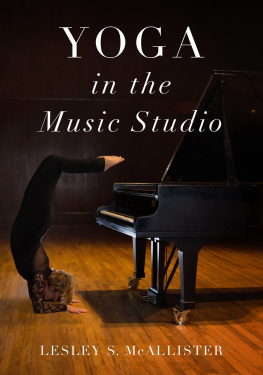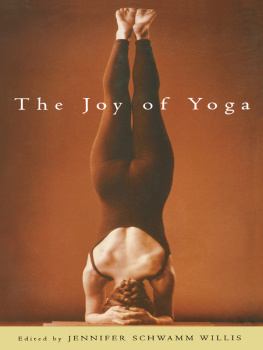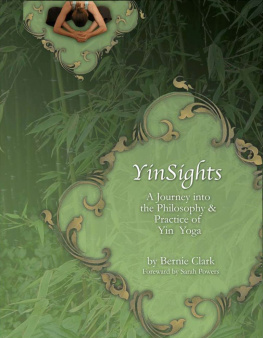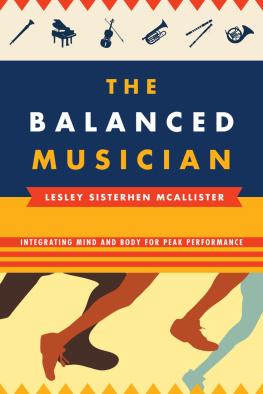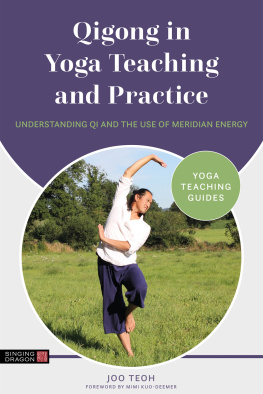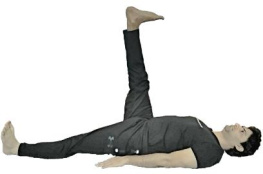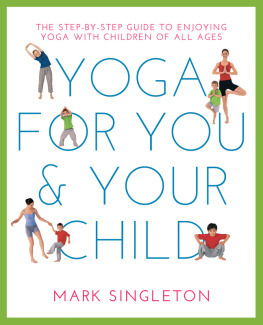Yoga in the Music Studio

Oxford University Press is a department of the University of Oxford. It furthers the Universitys objective of excellence in research, scholarship, and education by publishing worldwide. Oxford is a registered trade mark of Oxford University Press in the UK and certain other countries.
Published in the United States of America by Oxford University Press
198 Madison Avenue, New York, NY 10016, United States of America.
Oxford University Press 2020
All rights reserved. No part of this publication may be reproduced, stored in a retrieval system, or transmitted, in any form or by any means, without the prior permission in writing of Oxford University Press, or as expressly permitted by law, by license, or under terms agreed with the appropriate reproduction rights organization. Inquiries concerning reproduction outside the scope of the above should be sent to the Rights Department, Oxford University Press, at the address above.
You must not circulate this work in any other form and you must impose this same condition on any acquirer.
Library of Congress Cataloging-in-Publication Data
Names: McAllister, Lesley Sisterhen, 1977 author.
Title: Yoga in the music studio / Lesley McAllister.
Description: New York : Oxford University Press, 2020. |
Includes bibliographical references and index.
Identifiers: LCCN 2019053064 (print) | LCCN 2019053065 (ebook) |
ISBN 9780190915001 (hardback) | ISBN 9780190915018 (paperback) |
ISBN 9780190915032 (epub)
Subjects: LCSH: MusiciansHealth and hygiene. | Yoga.
Classification: LCC ML3820 .M4 2020 (print) | LCC ML3820 (ebook) |
DDC 613.7/04602478dc23
LC record available at https://lccn.loc.gov/2019053064
LC ebook record available at https://lccn.loc.gov/2019053065
To my son Camden Patrick, whose yoga stretches and acrobatics from inside the womb kept me company as I wrote this book.
Contents
Effective music teaching enables students to do much more than read musical notation accurately and play with a steady beat: it develops sensitive listening, fluent and efficient technique, an artistic sensibility, freedom from anxiety, and effective practice strategies, to name just a few skills among many. But all of these abilities require one tool in particular: awareness. Yoga is, primarily, about developing awareness: of breath, body, and movement, all of which work in conjunction to create sound in a musical performance. The student who practices mindfully is not only less likely to suffer from tension or its common companion, poor sound quality; he is also better prepared for performance situations, when adrenaline results in more intense focus and sharpened senses. Each time a student enters a practice room, the studio, or the recital hall, she must practice mindfulness. Yet, students often fall short of their potential because they lack specific strategies to commit to deliberate and focused work, and to let go to the moment, trusting that the work done in the practice room will yield fruit in performance.
The ancient practice of yoga, which has exploded in popularity in the United States over the past two decades, has the potential to change the culture of a music studio so that students practice more mindfully and reach peak performance more quickly. This potential remains untapped for the majority of music teachers and their students, even for those who have witnessed the benefits of yoga practice in their own lives. Understanding the connection between the mind and the body, learning to focus on the breath and the minute physical sensations that occur during stillness, and learning to accept what occurs in each momentthese are the skills that a consistent yoga practice develops, and they are also crucial for the performing musician.
Yoga may be used in music lessons for students of all instruments, at all ages, and at all levels of advancement. This book is designed for the professional musician and music instructor who wishes to incorporate yoga practice into the teaching studio through physical postures, intentional breathing, and possibly meditation. Each chapter explores the unique benefits of yoga for a particular population of students, describing specific poses and sequences that teachers can immediately implement into private lessons or group classes.
sets the foundation for an understanding of what yoga is and how that definition has changed over the last century, especially in the West. Beginning with an explanation of the original intention of yogathat is, to yoke the mind, body, and spiritthis chapter explores how the practice of yoga and music work synergistically to develop better body awareness, less physical tension, and greater physical and emotional well-being. After describing the types of poses and their benefits as well as how they may be sequenced for a well-rounded practice, sections on necessary supplies and safe practice tips will give pertinent information to teachers and students who are just beginning a yoga practice. Principles of breath, movement, and alignment are outlined so that teachers know what to watch for in their students and what cues to use as they begin to incorporate yoga postures into music lessons.
delves more deeply into the holistic practice of yoga as it bridges the conscious mind and the feeling bodytwo parts of the self that are often considered as separate entities but work holistically to impact well-being. Information on mindfulness, meditation, and pranayama, or the art of breathing, show how mindful movement and attention to the breath enhance focus and impact musical performance. The section on pranayama, or breath work, describes diaphragmatic breathing and the Ujjayi breath as well as more advanced breathing techniques that either relax or stimulate body and mind. Basic information is given on yogic concepts such as chakras, bandhas, drishtis, mantras, and mudras to provide a foundation for the use of these techniques with specific populations.
The most research-oriented part of the book, , describes how yoga has proven to be beneficial not only for physical health and wellness, but also for emotional well-being and optimal cognitive functioning. The emotional benefits of yoga directly lead to the physical benefits in reducing the symptoms of disorders that are caused or magnified by stress. This chapter outlines yogas potential in relieving performance anxiety, improving concentration, and increasing the likelihood of achieving a flow state in performance. Finally, research on attention, cognition, and the benefits of yoga for students with ADHD and other behavioral disorders demonstrates the usefulness of yoga techniques to increase retention and focus in the music lesson.
Beginning with on Recreational Music Making both offer innovative strategies for expanding a music studios offerings and supplementing income in effective ways that have yet to be explored by many teachers.
The sequences in these chapters are written as scripts to be read aloud to students. While some of the same poses occur in multiple chapters, the reader may benefit from on adolescent and professional musicians have many similarities, with several exercises that may be used interchangeably.
For teachers interested in working with preschool students, explores how early childhood music and movement classes might utilize appropriate yoga postures and breath work for very young children from the ages of three to six. Building on research on the benefits of music education starting in early childhood, as well as research on the importance of slow, integrated movement for optimal learning and neuromuscular development, this chapter shows how introductory musical concepts may be blended with yoga postures and breath work to enhance attention, motivation, and aural awareness. Some of the proposed poses emphasize crossing the midline, which enhances integration across the two hemispheres of the brain. In addition to containing many pictures and creative planning ideas for games and partner poses, it concludes with a sample curriculum for an eight-week summer music course. The postures and breath work may also be used with elementary-age students, so the final section describes how specific techniques might be incorporated in the private lesson, as well.

